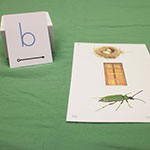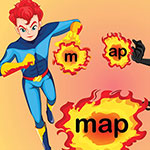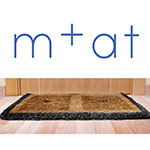Word Families
F1: What’s My Word? Part 1
Blend the first sound (phoneme) together with the remainder of a spoken one-syllable word, using picture cards as visual clues.
F2: What’s My Word? Part 2
Blend the first sound (phoneme) together with the remainder of a spoken one-syllable word, using picture cards as visual clues.
F3: What’s My Word? Part 3
Blend the first sound (phoneme) together with the remainder of a spoken one-syllable word, using picture cards as visual clues.
F4: Word Maker, Part 1
Blend the first sound (phoneme) together with the remainder of a spoken one-syllable word, but with no picture clues.
F5: Word Maker, Part 2
Blend the first sound (phoneme) together with the remainder of a spoken one-syllable word, but with no picture clues.
F6: Word Maker, Part 3
Blend the first sound (phoneme) together with the remainder of a spoken one-syllable word, but with no picture clues.
F7: Building Rhymes, Part 1
Blend a beginning sound (phoneme) together with other spoken word parts to make rhyming words.
F8: Building Rhymes, Part 2
Blend a beginning sound (phoneme) together with other spoken word parts to make rhyming words.
F9: Building Rhymes, Part 3
Blend a beginning sound (phoneme) together with other spoken word parts to make rhyming words.
1. Overview
This section is a bridge leading to a child’s being able to hear one sound (phoneme) of a word in isolation and blend it together with a spoken word family ending to form a whole word.
Professional educators may refer to these as Onset-Rime activities. The onset is the beginning of a word, before the first vowel, and the rime (not to be confused with rhyme!) is the remainder of the word. For example, the word split can be broken down into its onset spl and its rime it. Dog has the onset d and the rime og. Not every word has an onset: for example, the word it has only a rime.
In this section we will focus only on one-syllable words with a simple onset that has only one sound (phoneme): words like dog but not frog. Some educators call this a CVC construction, where C stands for consonant and V indicates a vowel.
2. Prerequisites
Here are a few things parents and teachers must do before teaching this section (and the following sections) to their children or students:
- Learn how to pronounce the individual sounds (phonemes) correctly. Start with the consonant sounds, because that’s what you’ll use in the Word Families activities.
- Use the right child-appropriate terminology. When teaching children, explain that lower-case letters are “the pictures of what the sounds of the alphabet look like when we write them or see them printed in a book.”
- Always have a copy of the written sound (the lower-case letter) for the beginning (onset) of the word in front of the child while doing these activities. For example, you will put out a d card when playing a game that focuses on the word duck. This will draw the child’s attention to the written sound while you pronounce it in the word.
3. Word Families Activities
- F1: What’s My Word? Part 1 – Blend the first sound (phoneme) together with the remainder of a spoken one-syllable word, using picture cards as visual clues.
- F2: What’s My Word? Part 2 – Blend the first sound (phoneme) together with the remainder of a spoken one-syllable word, using picture cards as visual clues.
- F3: What’s My Word? Part 3 – Blend the first sound (phoneme) together with the remainder of a spoken one-syllable word, using picture cards as visual clues.
- F4: Word Maker, Part 1 – Blend the first sound (phoneme) together with the remainder of a spoken one-syllable word, but with no picture clues.
- F5: Word Maker, Part 2 – Blend the first sound (phoneme) together with the remainder of a spoken one-syllable word, but with no picture clues.
- F6: Word Maker, Part 3 – Blend the first sound (phoneme) together with the remainder of a spoken one-syllable word, but with no picture clues.
- F7: Building Rhymes, Part 1 – Blend a beginning sound (phoneme) together with other spoken word parts to make rhyming words.
- F8: Building Rhymes, Part 2 – Blend a beginning sound (phoneme) together with other spoken word parts to make rhyming words.
- F9: Building Rhymes, Part 3 – Blend a beginning sound (phoneme) together with other spoken word parts to make rhyming words.
Leave a Reply




One Response to “Word Families”
GRACE ALWYN
A very useful teaching resource, interesting.
Thanks for the same.